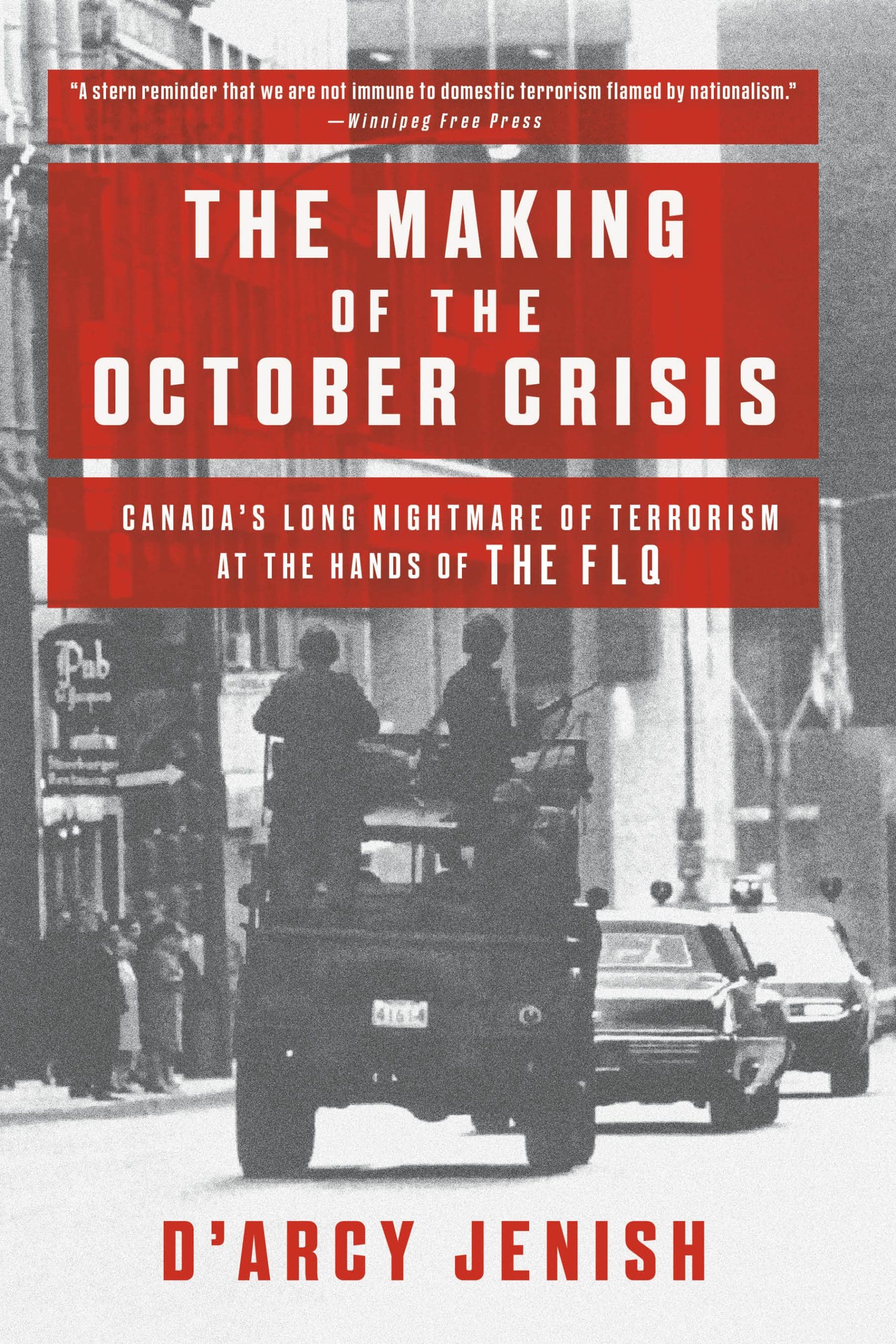No gift registry found click here to create new registry
Cart contain Gift Registry Items cannot add products
The Making of the October Crisis: Canada’s Long Nightmare of Terrorism at the Hands of the FLQ
| by |
|---|
17.00 JOD
Please allow 2 – 5 weeks for delivery of this item
Add to Gift RegistryDescription
A definitive, mind-changing history of the October Crisis and the events leading up to it.The first bombs exploded in Montreal in the spring of 1963, and over the next seven years there were hundreds more bombings, many bank robberies, six murders and, in October 1970, the kidnappings of a British diplomat and a Quebec cabinet minister. The perpetrators were members of the Front de libération du Québec, dedicated to establishing a sovereign and socialist Quebec. Half a century on, we should have reached some clear understanding of what led to the October Crisis. Instead, too much attention has been paid to the Crisis and not enough to the years preceding it.Most of those who have written about the FLQ have been ardent nationalists, committed sovereigntists or former terrorists. They tell us that the authorities should have negotiated with the kidnappers and contend that Jean Drapeau’s administration and the governments of Robert Bourassa and Pierre Trudeau created the October Crisis by invoking the War Measures Act. Using new research and interviews, D’Arcy Jenish tells for the first time the complete story—starting from the spring of 1963. This gripping narrative by a veteran journalist and master storyteller will change forever the way we view this dark chapter in Canadian history.
Additional information
| Weight | 0.41 kg |
|---|---|
| Dimensions | 2.57 × 15.32 × 22.79 cm |
| PubliCanadation City/Country | Canada |
| by | |
| format | |
| Language | |
| Pages | 384 |
| publisher | |
| Year Published | 2020-10-6 |
| Imprint | |
| ISBN 10 | 0385663277 |
| About The Author | D'ARCY JENISH is the author of Epic Wanderer: David Thompson and the Mapping of the Canadian West and the award-winning Indian Fall: The Last Great Days of the Plains Cree and the Blackfoot Confederacy. His sports histories include The Montreal Canadiens, The NHL and the bestselling The Stanley Cup: A Hundred Years of Hockey at its Best. |
Shortlisted for the 2019 John W. Dafoe Book PrizeA Hill Times Best Book of 2018"In the current age of terrorism, the merit of this thorough, compelling book is the timely way Jenish reminds us of the scale and intensity of this previous cycle of political violence. . . . A veteran of long-form journalism, Jenish knows how to gather tidbits from disparate sources—police reports, coroner inquests, newspaper clippings—and weave them to recreate narrative scenes, crafting a more appealing read for the general public than other works of the same scope." —The Globe and Mail"Fascinating, frightening. . . . The Making of the October Crisis is a book that finally gives a complete, well-rounded, factual account of one of the darkest times in modern Canadian history." —Montreal Times "In these times of severe hate and violence in the United States, D'Arcy Jenish's The Making of the October Crisis . . . is a stern reminder that we are not immune to domestic terrorism flamed by nationalism. . . . Jenish's talent is in being able to tie all the events of this infamous decade together." —Winnipeg Free Press"[D'Arcy Jenish] has written a brisk, well-researched and richly detailed account of the 'two hundred bombings, dozens of bank robberies, six deaths and two kidnappings' that jangled Quebec's nerves from early 1963 until the fateful fall of 1970. . . . For those who have forgotten much of the detail of the October Crisis and its roots, and for those for whom it's undiscovered territory, Jenish has written a must-read guide." —Canada’s History"An authoritative work on the period." —The Guardian (UK)"What I found fascinating about this book was it didn't zero in on the events of that October itself. It started 10 years earlier. The author carefully laid out where the unrest came from. I could relate with some of that unrest as an Indigenous person. I could understand some of the fear that francophones were having around their culture and their language. He carefully laid out how the political idealism and the radical break off that led to this October Crisis, the kidnapping of two government officials and the eventual death of a Canadian minister." —Candy Palmater, CBC.ca |
|
| Excerpt From Book | PrologueThere had been over two hundred bombings, dozens of bank robberies, six deaths and two kidnappings, all committed in the name of the Front de libération du Québec, all in the space of seven and a half years, and then this—one of the hostages brutally murdered at the hands of his abductors. The other victims of FLQ terrorism had been ordinary citizens—a night watchman, the vice-president of one of Canada’s largest firearms stores, one of the employees, a secretary, an Ottawa grandmother who worked for the Department of National Defence and a sixteen-year-old youth who had died when the bomb he was planting exploded in his hands.The latest casualty—Pierre Laporte—was strangled. He was forty-nine years old and a prominent Quebecker. He had been the legislative correspondent for the Montreal daily Le Devoir—the newspaper of choice for Quebec’s political, cultural and intellectual elite. He had also been a member of two provincial Liberal governments and a cabinet minister in both. He was well liked by his constituents and respected by his colleagues, one of whom described him as “the best parliamentarian in the National Assembly.”Laporte was murdered on a Saturday evening, amid the October Crisis of 1970, and the services held to honour him reflected his stature. From midday Sunday until midday Tuesday, his body lay in state in an open casket in the grand, marble-walled lobby of the Palais de justice courthouse on Notre-Dame Street in Old Montreal. The flag of Quebec was draped over the casket and four members of the Sûreté du Québec—the provincial police force—stood guard. Pierre Trudeau and Robert Bourassa were among the first dignitaries to pay their respects. They walked the short distance from City Hall flanked by machine gun–wielding soldiers, mounted the broad stone steps of the Palais de justice, stepped past the twenty-foot-high burnished-brass doors and stood before the casket for a few moments with heads bowed.Thousands upon thousands of ordinary citizens waited their turn in unseasonably chilly autumn weather and in streets thick with soldiers dressed and armed for combat. The lineups stretched for blocks, and when their moment came, men, women and children swept silently past the casket and through the lobby and back to the street.Premier Bourassa offered a state funeral in Old Montreal’s ornate and magnificent Notre-Dame Basilica, but Madame Laporte insisted on a simple requiem celebrated without organ or choir or dirge, and open only to family and friends and her late husband’s peers from the realm of politics. Parishes across Montreal and throughout Quebec held commemorative masses, similar services were held in Ottawa and Toronto, and all Quebec government offices were closed on the afternoon of the funeral.It was set to begin at 4 p.m., but long before that the authorities had taken every precaution to ensure the safety of those attending, and that included the prime minister, most of his Cabinet and at least one hundred MPs from all parties, the premier of Quebec and every member of the National Assembly, Montreal’s mayor and city councillors, and municipal politicians from the Montreal area.The streets for several blocks around the basilica were barricaded. Soldiers armed with rifles—and bayonets attached to the barrels—kept motorists out. Army snipers were posted on rooftops. Troops manned a machine-gun nest between the two massive towers that soared above the front doors of the basilica. Police had earlier searched every inch of the interior. Barricades had been erected around Place d’Armes—the square in front of Notre-Dame—and they held back onlookers six to seven deep.The dignitaries arrived in limousines, aboard school buses and on foot. Once everyone was seated inside the basilica, three police officers on motorcycles slowly made their way through the onlookers, followed by the hearse bearing Mr. Laporte’s body. “The hush that fell over the crowd was so absolute that a policeman’s footsteps echoed loudly across the square,” one journalist noted, and others reported that an air of silence fell over much of the city as the service was about to begin.It lasted forty-five minutes. Maurice Cardinal Roy of Quebec City presided and was assisted by Archbishop Paul Grégoire of Montreal and two parish priests. Afterward, pallbearers carried the casket to the hearse, followed by Madame Laporte, whose face was covered by a thick veil, and her two children, twenty-year-old Claire and ten-year-old Jean.The family had barred reporters and photographers from attending, but one worshipper told a journalist, “I’ve never known anything like it. There was this enormous church and not a sound. Not a whisper. People didn’t talk to each other, rarely shook hands and kept their eyes on the floor. I suppose there was nothing to say. We were stunned.” |
Only logged in customers who have purchased this product may leave a review.
Related products
-
On backorder 2-5 Weeks to Arrive
Add to Gift Registry100.00 JOD -
Low stock
Add to Gift Registry17.99 JOD -
On backorder 2-5 Weeks to Arrive
Add to Gift Registry37.99 JOD -
On backorder 2-5 Weeks to Arrive
Add to Gift Registry36.99 JOD






Reviews
There are no reviews yet.